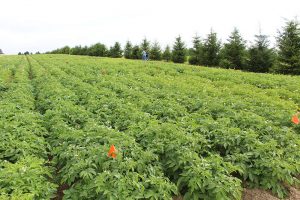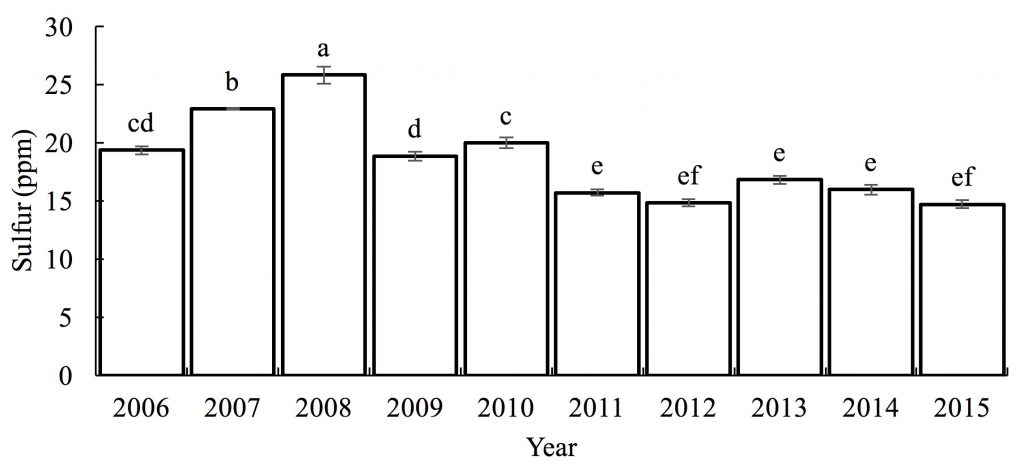Bulletin #1081, Potato Farmers in Aroostook County, Maine, Should Test for Soil S and Correct as Needed
Developed by Lakesh Sharma, University of Maine Cooperative Extension Assistant Professor of Sustainable Agriculture, and Sukhwinder Bali, Assistant Professor of Sustainable Agriculture, University of Maine Cooperative Extension
For information about UMaine Extension programs and resources, visit extension.umaine.edu.
Find more of our publications and books at extension.umaine.edu/publications/.
Why soil sulfur (S) levels matter to Aroostook County potato farmers

Sulfur is often referred to as the fourth essential macronutrient to support plant growth and development. S deficiency can rarely be seen in potato foliage, but it can affect crop quality and yield. With high-yielding potato varieties and decreasing S deposition due to U.S. Environmental Protection Agency (EPA) regulations to reduce air pollution, typical soil S values have reached critically low levels (≤15 ppm). In potatoes S plays a role in nutrient uptake, chlorophyll production, seed development, stress and pest resistance, and vitamin synthesis.
Importance of potato crops in Maine
Potatoes are Maine’s most valuable agricultural commodity, worth almost $174 million per year. About 47,000 acres of potatoes are grown in Maine, 90% of which are grown in Aroostook County.1
What was done
UMaine Extension analyzed data from soils sampled from Aroostook County, Maine, between 2006 and 2015 to determine the levels of sulfur (S) in the rooting zone. Each year UMaine Soil Lab receives an average of ~1,100 soil samples for analysis. Farmers and home gardeners regularly send soil samples to the UMaine Soil Lab, mostly in autumn, for chemical analysis and fertilizer recommendations relevant to the crop they intend to grow. The majority of samples tested from Aroostook County were intended to grow potatoes.
Sulfur trends in Maine’s environment
The UMaine Soil Lab states that optimum S levels for potato growth in Maine soils are greater than 15 parts per million (ppm), or 10–20 ppm. S enters the atmosphere via air pollution and comes back to earth with precipitation. Federal regulations have reduced air pollution and the resulting deposition of S to the soil. Soil sampling finds statistically significant decreases in S over the study period (2006–2015) (Figures 1 and 2).


The other reason for decreasing S levels in Aroostook County soils might be changing in cultural practices. Farmers typically try to maintain low soil pH to protect their potato crop from scab issues. Ammonium sulfate fertilizer application supplies nitrogen, keeps pH low, and provides supplemental S. But with scab-resistant potato varieties and increasing crop rotation, farmers are using other nitrogen sources, such as ammonium nitrate, diammonium phosphate, and urea for supplemental nitrogen application. These sources contain no S, and reduce S levels in the soil.
S levels in Aroostook County potato fields2
Our analysis suggests that average soil S levels in the rooting layer are at 15 ppm, so soon evidence of S deficiency may begin to appear. The data represent soils collected from about 1,100 fields, so some fields may already be experiencing S deficiency. Because S deficiency is difficult to see visually in potatoes, unless the rates are less than about 5 ppm, Maine growers may not be aware of an existing S problem in their fields.
What should Aroostook County potato growers do?
S deficiency in potatoes is a hidden problem that does not present clear deficiency symptoms in the foliage but may result in a significant decrease in yield. Therefore, we recommend that all potato growers in Aroostook County annually send rooting zone soil samples to the Analytical Lab and Maine Soil Testing Service for standard analysis, including S levels. The test results will come with fertilizer recommendations, which should be heeded for optimum yield. Growers should also use a foliar or granular S fertilizer supplement on the potato crop.
For more information, contact:
Lakesh Sharma, Soil Specialist
Assistant Professor, Extension and Sustainable Agriculture
University of Maine Cooperative Extension, Presque Isle Office
57 Houlton Road
Presque Isle, Maine 04769
Office Phone: 207.764.3361
Fax: 207.764.3362
Cell: 207.498.0316
lakesh.sharma@maine.edu
Lakesh Sharma Staff Directory Listing
1 Data from USDA National Agricultural Statistics Service Quick Stats
Information in this publication is provided purely for educational purposes. No responsibility is assumed for any problems associated with the use of products or services mentioned. No endorsement of products or companies is intended, nor is criticism of unnamed products or companies implied.
© 2017
Call 800.287.0274 (in Maine), or 207.581.3188, for information on publications and program offerings from University of Maine Cooperative Extension, or visit extension.umaine.edu.
In complying with the letter and spirit of applicable laws and pursuing its own goals of diversity, the University of Maine System does not discriminate on the grounds of race, color, religion, sex, sexual orientation, transgender status, gender, gender identity or expression, ethnicity, national origin, citizenship status, familial status, ancestry, age, disability physical or mental, genetic information, or veterans or military status in employment, education, and all other programs and activities. The University provides reasonable accommodations to qualified individuals with disabilities upon request. The following person has been designated to handle inquiries regarding non-discrimination policies: Director of Equal Opportunity and Title IX Services, 5713 Chadbourne Hall, Room 412, University of Maine, Orono, ME 04469-5713, 207.581.1226, TTY 711 (Maine Relay System).

